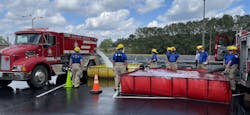Firefighter Training Drill: Moving Big Water in Rural Settings
In the world of firefighting, there hardly is anything that’s more important than a solid water supply plan. For many departments, this is as simple as pulling up to the closest hydrant and completing a forward lay to the fire or calling for the next-due apparatus to complete the water supply from a nearby hydrant. For departments that rely on water sources other than hydrants, this matter takes a great deal of training.
Training & considerations
Many departments make daily use of a tanker or tender to put out fires. However, how many take the time to think about the training and thought processes that are needed to provide mobile water supply when big water is needed? Consider the large buildings that are in your area. Do you have the tankers that would be needed to keep a 1,500–2,000-gpm flow going?
How about thinking even bigger than that? How about a fire that has two separate pump sites that support two ladder pipes on a large church fire?
How about in regard to subdivisions that are coming to rural areas at an accelerated rate? What are the sizes of the houses? In the area where I live, most of the new houses are almost twice the size in square footage than that of the houses that were constructed 20 years ago. We are seeing a construction trend of houses that are in the 2,500–3,000-sq.-ft. range. That’s between 850–1,000 gpm for 100 percent involvement. Can this fire flow be handled with a mobile water supply scenario? Absolutely, it can, but you must train on this type of incident.
Start by thinking, what is the largest building that’s in your area? Do you have enough tankers in your district to support the water flow that building would need?
Then come up with a big water training evolution. This should be a multistep evolution, which will take time to complete. The old saying that you must crawl before you walk is particularly true when it comes to preparing yourself for the biggest fires that your department might face.
Drafting
Drafting drills come first. Of course, departments that utilize tankers are up to par with pulling a draft, but stacking five or six drop tanks beside each other takes practice to keep up with the amount of water that’s needed for the massive flows that a big incident might need.
Position an attack pumper, then position a supply pumper to draft and send the water to the attack pumper and another pumper, to be able to shift the water from drop tank to drop tank. This is a process that commonly is done with two or three drop tanks, but when you start to add more than that, you must have a dedicated engine just to leap frog the water from drop tank to drop tank without the attack engine losing the capability to put the much needed water on the fire.
Fill site
A static water source often is the best bet to supply tankers with the minimum fill rate of 1,000 gpm. Remember the basis of mobile water supply and put the rig that has the biggest pump at your draft site, so you can fill tankers at the fastest rate possible. This can be accomplished by using a large-diameter hose with a Y attachment and 3-inch fill lines.
My department trained on this doing it with a manifold, so we could have four 3-inch lines to hook up one tanker while another was filling. A crew stood by ready to hook up and break down the attachments, to make filling as efficient as possible.
Also, look at the possibility of having multiple fill sites, to prevent having too many tankers stacked up waiting to be filled. Remember, the key word is mobile.
Travel
One of the most important things that must be considered is the travel route from the fire to the fill site and then back to the fire. The biggest hurdle that must be overcome most of the time is the miles that are between the fill site and the fire. You can drive only so fast, so it’s imperative that you train in a way so that there isn’t any lag in getting the tankers filled and back to the drop site.
Make sure that you keep everything flowing in a circle. You are more efficient when drivers have the ability to pull beside the drop tank and dump, instead of having to back up. This also makes the operation safer and has less likelihood of injury or damage.
Rhythm
Providing mobile water supply when big water is needed is a large process that takes a lot of hands to make happen. Training on it pays big dividends when it comes to keeping master streams flowing.
You might come up with different ways to complete a drill, but the time to figure out how to flow big water with shuttle as your water supply isn’t when a building catches fire. The citizens who you swore to protect deserve your very best every time that you run a call, so you must make sure that you are ready for this possible scenario. This includes the people who will be in charge of the operations.
Train as if it’s a real call. Get yourself in a rhythm with the process, so everyone is as efficient as possible. You have no excuses to not get better at everything that you do. Go out with your members, train for the worst, be ready to serve, and, most of all, have fun and be safe.
